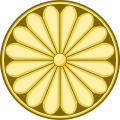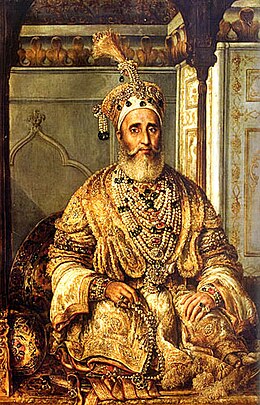This is an old revision of this page, as edited by Maurya-E-Mughal (talk | contribs) at 16:56, 23 December 2024 (←Removed redirect to List of emperors of the Mughal Empire). The present address (URL) is a permanent link to this revision, which may differ significantly from the current revision.
Revision as of 16:56, 23 December 2024 by Maurya-E-Mughal (talk | contribs) (←Removed redirect to List of emperors of the Mughal Empire)(diff) ← Previous revision | Latest revision (diff) | Newer revision → (diff) Not to be confused with Emperor of India.Emperor of Hindustan sometimes also translates as Emperor of India was a imperial title used by the Delhi Sultanate and the Mughal Empire to signify their sovereignity over Northern India and later the Indian subcontinent.


The term was simultaneously used for Northern India and the Indian subcontinent.
During the rule of the Mughal Empire in the 16th century, the term was equivalent to Emperor of India, which was later used by the British monarchs.
Variations like Sultan of Hindustan and Sultan-e-Hind were also used
| Emperor of Hindustan | |
|---|---|
| Imperial | |
 Imperial Seal Imperial Seal | |
 Last to reign Last to reignBahadur Shah II 28 September 1837 – 21 September 1857 | |
| Details | |
| Style | Imperial Majesty Jahah Panah Alam Panah |
| First monarch | Qutb ud-Din Aibak |
| Last monarch | Bahadur Shah II |
| Formation | 25 June 1206; 818 years ago |
| Abolition | 21 September 1857; 167 years ago |
| Residence | |
| Appointer | Hereditary |
History
Delhi Sultanate
After the Delhi Sultanate gained independence from the Ghurid Empire, it called it's land Hindustan, representing its sovereignity over Northern India (Punjab and the Indo-Gangetic plains) and later the Indian subcontinent.
Scholar Bratindra Nath Mukherjee states that during periods of Delhi Sultanate, Hindustan simultaneously represented Northern India aswell as the entire Indian subcontinent.
Mughal Empire
The Delhi Sultanate was succeeded by the Mughal Empire, which called it's polity as Hindustan. By this period, Hindustan had come to mean the entirety of the Indian subcontinent rather than only Northern India.
Variations
The title Emperor of India was also used for the Mughal Emperors in some translated sources, a term later used by the British Monarchs.
Other variations were also used:
Sultan of Al-Hind (Salṭan-i-al-Hindīyyah)
Sultanate of Hindustan (Salṭan-i-Hindūstan)
Cite error: There are <ref group=Note> tags on this page, but the references will not show without a {{reflist|group=Note}} template (see the help page).
- Larned, Josephus Nelson (1895). History for Ready Reference: From the Best Historians, Biographers, and Specialists; Their Own Words in a Complete System of History ... C.A. Nichols Company.
- Hindustan), Jahangir (Emperor of (1999). The Jahangirnama: Memoirs of Jahangir, Emperor of India. Freer Gallery of Art, Arthur M. Sackler Gallery. ISBN 978-0-19-512718-8.
- Jackson, Peter (2003-10-16). The Delhi Sultanate: A Political and Military History. Cambridge University Press. p. 86. ISBN 978-0-521-54329-3.
- Mukherjee, Bratindra Nath (1989). The Foreign Names of the Indian Subcontinent. Place Names Society of India.
- Vanina, Evgenii͡a I͡Urʹevna (2012). Medieval Indian Mindscapes: Space, Time, Society, Man. Primus Books. ISBN 978-93-80607-19-1.